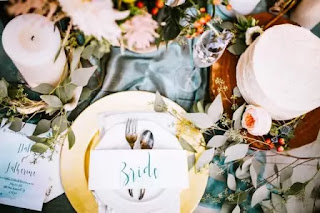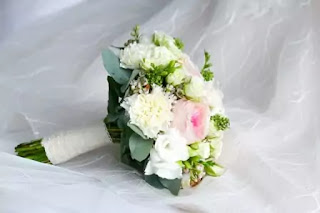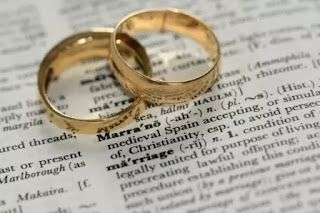Complete facts on cleaning and preserving wedding gowns
Having your wedding gown cleaned and preserved as soon as possible after your wedding helps you produce great results. You can still clean and protect your gown years later, but problems can occur due to delays. Which of the three wedding gown protection methods is the best?
There are many wedding gown preservation companies that claim that their special approach is the best. There is no need to get confused when you have the facts. This special report is designed to educate you so that you can understand yourself in three ways with its various pros and cons.
Jump To -
Fresh Wedding Flowers - Have You Order These Nine Arrangements For Your Wedding Day
When you have combated this report, you need to decide the fact that which method you want to use for the preservation of your wedding gown.
What you'll find inside this wedding gown preservation report:
Chapter 1
Top 5 reasons to clean and preserve your wedding gown:
-Remember your special day
Celebrate an anniversary
For use by a family member
-For a cresting dress
- For a basin pocket cover
Chapter 2
How to clean your wedding gown:
-dry cleaning
-Back Cleaning
Chapter 3
Three types of wedding gown protection:
- box method
Closed box method
-Bugging method
Chapter 4
Disclosing Myths, Misinformation, and True Falsehood:
-Boxing vs Bagging
- "Museum" storage
-Cloth Bag Storage
Bad storage
- Boxed Storage Seal
-Wearing the wife
-Model and mildew growth
-Infectious infection
-Breathing with a cloth to breathe
Chapter 5
Wedding gown protection goals:
-Moving
-Remains decreases
-Seed spots and oxidation
Chapter 6
Upgrade Offer:
-What is included in an upgrade
-What is the value of an upgrade
-Why is it an upgrade offer
Chapter 7
Wedding Gown Cleaning and Protection Summary.
Chapter 1
5 Top Reasons Why Your Wedding Gown Is Clean And Preserved.
1. The first and most important reason is clearly that it is your wedding gown. It is the most expensive dress for you and it is part of the celebration of the most important day of your life. This is the dress in all your wedding pictures. This is one of the things that you will miss the most about your marriage.
Surely you have your photos, but being able to really look at your actual wedding dress beautifully will always bring a flood of amazing memories.
2. You can wear it to celebrate your 5th, or 10th, or 25th wedding anniversary. You can put it on an effigy and display it for an anniversary celebration.
3. Wedding gown preservation keeps your dress in perfect condition so your sister or your daughter or granddaughter can also wear it on their wedding day. (This happens more often than you might think and is a great opportunity for you and the lucky girl wearing it.)
4. Many brides are making a Christmas dress from their wedding gowns. Being able to dress your wedding gown in a dress that your precious daughter will wear on this important day. This can usher in a great family tradition and heritage.
5. Something that is starting to take off in popularity is creating a basinet cover. This can be done easily and provides a wonderful reminder of your special day and the special little one inside the basket.
No problem, wedding gown protection is important. You may not think so now, but years later, you do not want to regret that you missed the opportunity. A time will come when you want your wedding gown in beautiful condition again.
Many brides leave their dress in a plastic garment bag after the wedding and think they will "occasionally" preserve it. There are always good intentions, but this "sometimes" changes over weeks or years. You may have some serious risks to your gown.
You know that there are some stains on your wedding gown. There is sometimes dirt, grass spots, and sometimes asphalt parking lot oil on the hem of your dress. Then there is underarm deodorant, sweat, body oil, makeup, spray tan which is found on the dress. Even a wine spill or two may occur.
There may also be stains that are not easily visible, such as soda, champagne or cake frosting. Stains caused by any liquid will oxidize and turn brown over time. The longer a stain is, or the more difficult it is to remove. It is important to keep your wedding gown clean and protected to prevent this from happening.
Plastic is made from petroleum and fumes. These chemical fumes cause yellowing in your dress. That is why you should never take your dress to the dry-cleaner and leave it in the plastic bag that comes into the house.
Hanging your dress can cause additional problems. Your wedding gown is very heavy and hanging it will pull clothes and sew. If your dress has a sleeve then the weight of the dress will increase the speed of the sleeve. If it is strapless or you hang your dress with side-seam hanging loops then the manufacturer allows you to provide fabric and side-seam. And for those clothes with a long heavy train, the loop for the train may be true.
Properly done wedding gown protection can protect your valuables.
Chapter 2
How to clean your wedding gown?
There are two methods of cleaning: dry-cleaning and wet-cleaning.
#Dry-cleaning is not really dry at all. Dry-cleaning means not using water for cleaning. It is cleaning with a petroleum solvent as a cleaning agent. The most common agent for dry-cleaning is perchloroethylene - the "perk" for short. It is an excellent degreaser and can be used on all fabrics including silk, acetate, rayon, and polyester. This can damage some sequins and beads. This can melt the coating on some beads and melt the glue if the beads and sequins are glued onto the fabric.
The Stoddard solvent is not as popular because it is more expensive and has more rules for its use - such as it cannot be used in a facility in strip malls. This is an excellent degradation but has the added advantage that it will not damage beads or sequins.
Exxon DF-2000 is also a petroleum-based solvent. It will not harm beads or sequins but is not as good of an offending as a Stoddard solvent. It has fewer regulations so it is more popular for some dry-cleaning establishments.
The cleansing is called "Virgin Solvent". Virgin solvent is the solvent that has been specifically cleaned and filtered before each use. Many dry-cleaners use the same solvent, meaning that the solvent can retain residual oils and "dirt", which can be re-deposited on your dress. Dirty solvent will also leave a "dry-clean" smell on your dress.
There are many benefits to cleaning your dress using wet cleaning, water. Water is best for removing any type of sugar stains, food stains, or plain dirt on the hem. This is a bad degrading, (but petroleum solvents cannot remove sugar or food stains.) Wet-cleaning also prevents sizing in clothing (sizing is a starch-like substance that is applied by the manufacturer to the fabric's "body." "Used to give). Shaping in clothes attracts mice and insects.
There should be a care label inside your wedding gown which is recommended by the manufacturer.
Experience is the most important criterion to consider in choosing who should be cleaning and preserving your wedding gown. Asking questions is the most effective way to determine their experience. How long have they been in business? Do they specialize in wedding gowns, or only clean them once in a while? Do they examine each dress individually or just give it a place with their regular cleaning?
Chapter 3
3 types of wedding gown protection
There are three types of wedding gown protection:
1. Plain Boxing Method
2. Seal Box Method
3. Bagging method. Let's examine each one.
Plain boxed method. Your wedding gown is first cleaned and then placed on a cardboard bust form. Bust form and dress are safe in the box. If the bust form was not properly secured in the box, the dress would slide and end up in a dirty pile at the bottom of the box. The dress is folded and layered with tissue paper. The box may or may not contain a windowed display area. The box is closed and sent to you.
Seal Boxing Method. This method is similar to the plain boxing method, except that it goes one step further in preserving your wedding gown. The box is completely sealed. It is sealed to keep out moisture and keep insects out.
Bagging method. Again the gown is first cleaned and then usually hung on a padded hanger and then placed in some sort of cloth bag.
Chapter 4
Disclaimer of myths, lies, and misinformation.
Let us discuss these methods and publish misinformation, misconceptions, and correct lies about the methods of wedding gown reservation on the internet.
First, understand that companies using each of these methods try and convince you that their method is the best. But let's look at logical and scientific facts.
Boxing vs Bagging. Boxing methods provide a convenient sized preservation box that can be easily stored under a bed or under a closet. Bagging, depending on the size of your wedding gown, can be very heavy and take up a significant amount of closet space, especially if your gown was full or a train. Consider where you will store your protected wedding gown and how much storage space you will have.
The bagging method is also known as "museum" storage or "museum quality" storage. The pitch behind this is that museums put their clothes in bags and not boxes. This is partially true. Even their own information suggests that these museums also store dresses that fold in drawers.
The museum stores most of its dresses in bags. Most of their dresses are thin A-lines and wear regular clothes for women throughout their ages. These can be easily hung, take up very little "closet" space, and will only require light touch and preparation for display.
It is different with heavy clothes, trains and wedding dresses. As mentioned earlier, if they are bagged and hung, they sit in the closet in considerable quantities. Also if they are hanging the weight of the fabric, it can cause a stretch in the fabric. Have you felt the weight of some wedding dresses?
The dressmaker stitches a ribbon loop in the seam of the dress and recommends hanging it from those ends. Yes, the loops can be reinforced but still, the entire weight of the dress is suspended rapidly and this will cause the fabric to stretch. If the dress is a lightweight "destination style" dress, it won't make any difference.
#If the dress has a sleeve and is hung with a sleeve, the stretching may be worse. The shape of the sleeve may be distorted. The hanger in the top of the sleeve can leave permanent marks.
Other advantages: The purpose of this method is the inspection of the fabric and no folding of the fabric. When the wedding gown is protected by the bagging method, you can open the bag and easily check the dress. If the dress is short without a train, it should not be folded. If it has a train then the train will be hung in its suture by a ribbon loop and bend the halfway point of the train, this will return double fold for the last 12 "-24" of the train. Loop hanging the hem of the train. Remember how the train was hung in a bag on your wedding dress when you took it to your wedding. It will be hung the same way for this method. So clothes with trains always have at least two folds using the badging method. (If they don't actually hang the train with a hanging noose, the entire train will be a wrinkled mess in the bottom of the bag - there's no other place to go to it).
Finally, the clothes storage bags used in the Bagging method should be addressed. There are two areas of concern regarding insect infection when using cloth bags for storage. Insects can get into the smallest places and through the smallest cracks and openings. We have all experienced spiders, earwigs, pellet bugs, and other insects in some very unusual locations. Closure area, many bags have a zip in this bagging method which is usually closed. This may provide an opportunity for pests to enter into or among their relationships. The second is the hole in the top of the bag where the hanger passes. Insects can enter this opening and ruin their dress.
Cloth bags pass through the air but this also means that moisture can also pass through the dress. As the moisture increases, there is more moisture in the air and therefore in the fabric of your dress. It does not really matter much until the moisture gets too high and it can promote the growth of mildew on the fabric.
There may be something else with the cloth bag. Cats, dogs, and mice especially like to "mark" their territory. It has happened where an animal has urinated on a bag to mark its territory. Apparently, it can be soaked through a cloth bag and a wedding dress. The dress has to be cleaned again.
Okay, now let's discuss the boxing method. Two types of boxes can be used, one with a windowed display area in the top and the other with just plain cardboard boxes. It is indeed a personal preference for each person to decide.
The dress is first cleaned with this method of generating a wedding gown. It is then banged and pressed. It is then placed on a shaped bust form to fill the top of the dress and make it appear better. The bust form is attached to the box so that the dress does not slide back and forth across the box and ends up in the pile at the bottom of the box.
As the dress is placed in the box and folded and layered with acid-free tissue paper. This is to protect and soften the layering folds. If it is a plain cardboard box, a final layer of tissue paper is placed over the dress. If the box is a window display box then this layer is not used, so that you can see your dress through the display window.
The box can then be stored under a bed or under a closet.
The seal box method undergoes the same process with the additional step of sealing the entire box.
What are the advantages and disadvantages of each? The boxing method says that you can open the box and check that the dress is there to make sure it belongs to you and check it out. If it is a displayed display box, you do not need to make sure that it is your dress - you can see it through the window.
However, there are problems if you think you can just open the box and check the dress. First of all, you should never touch a clean and protected wedding gown unless you have white dress gloves. You may or may not have clean hands, but you will have body oils on your hands and therefore you will need gloves.
If you have white cloth gloves, when you open the box you will know that the bust form is attached to the box, so you will have to unscrew it. Next, you have to open the layer of the dress, layer to check the train which will be the bottom layer in the box. Once you are satisfied you will have to resell the dress as it was before and re-set the bust form. Much easier than it sounds.
If you actually take the dress out of the box, you will find it even more difficult to get everything in the box properly.
#Make something more completely sure before you open the box and try to check your dress. A wedding gown protection company is guaranteed. It may or may not say that you can open the box and check your dress. It can say that you can open the box to check your dress but does not specifically say if you can take the dress out of the box. If it is not specific, then you should ask specific questions to ascertain what you can or cannot do which will void their guarantee.
Wedding gown protection companies should protect themselves from the situation where a bride can take her dress out of the box, wear it, get something on it, put it back in the box, and claim that The stain or dirt or whatever was never left out is the original cleaning and preservation process and demand that it be redistributed for free.
Don't assume that just because the box is not sealed that you can open it, check the dress and take it out and not void the guarantee ... you need to check first.
Boxes that are not sealed are susceptible to insect infection. Insects love to build their nests in small thin openings and clothes. Just because the box is closed does not mean that insects cannot get inside.
The same warning is applied to sacks when it marks animals in its area. A cardboard protects better than a cloth bag but can still be ruined by the animal urinating on it.
Moisture and humidity can also vary in an unsalted box - the same caveat applies.
Then what about the seal box method? It provides great protection to all the benefits of the boxing method. You do not have to worry about animals or insects.
What about checking the dress in a sealed box and the question of moisture and mildew? A number of wedding gown protection companies site these two reasons as a warning to not use the seal box method.
Let's address them at once.
Here is the actual science on mold and mildew from a publication by the University of Florida Institute of Food and Agriculture Science. The optimum condition for mildew growth is 70% –98% relative humidity and 77–88 ° F. The growth of mildew stops completely when the relative humidity is less than 62%.
So if your wedding gown is either boxed or bagged but not sealed then there is a risk of mildew if you have high humidity and hot temperatures. If you live in an area of the country where humidity levels can exceed 70%, then your uncovered wedding gown can increase the risk of mildew growing on it. If your box is sealed and you have sealed a high amount of moisture in the box and the dress, you may also run the risk of mildew.
So for optimum wedding gown protection, you want to do box sealing or sealing boxing method with less moisture. This means that you need to make sure that your wedding gown protection company dries your dress and controls the humidity before sealing the box.
Another objection that some companies have made about the seal boxing method is that the fabric should be allowed to breathe. There is no lung in the fabric - it is not and should not be actually breathed. Breathing the cloth means that air is allowed to flow through the cloth.
The fabric acts as a natural filter. So if the air is allowed to circulate through the dress, more and more contaminants can build up on the fabric. A sealed box does not allow air to circulate and eliminates this problem. So do some companies pitch as detention that actually comes out as an advantage for sealing the box.
When this wedding gown comes with an inspection sealed boxing method, you simply cannot examine the dress thoroughly. You will want to choose a company that has a window display box so that it can see and verify your gown. If you open the box to take out your dress and examine it, you will void their guarantee.
This means that you have to "trust" the wedding gown protection company that you use the cleaning and protection right.
#Check the company. What kind of reputation do they have? Read their testimonials. Are they members of the Better Business Bureau and with what kind of ratings? How long have they been in business? Do they just specialize in wedding gowns, or do they do all kinds of dry-cleaning? Can you answer your questions in person?
Chapter 5
How do you want your wedding gown for you and your dress?
1. You want your wedding gown shielding to protect your dress from yellowing. Yellowing can be caused by many conditions. Do not use plastic bags for long-term storage. Plastic bags close the petroleum distillate which can turn your dress yellow over time. Storing your dress in a non-acid-free environment can also cause the yellowness of your dress. This would involve using regular tissue paper instead of a regular cardboard box, or acid-free tissue.
2. You want your wedding gown protection to prevent any permanent deficiency in your dress. Make sure that the company you use correctly takes care of your dress. If you insist on using the bagging method, they should make special provisions for your train so that it does not double back into the bag by itself. If you use boxing or seal boxing methods, they should bend the dress carefully and buffer each fold with acid-free tissue paper. This will make the buffering folds gents and protect them from shrinking.
(Keep in mind that some companies will promote the idea that your wedding gown should be re-folded every few years to prevent permanent creases. While this sounds good in theory, it's not true at all. First of all. If your gown is properly stored, buffer. With acid-free tissue paper, the chain of folds will remain. Unless there is some force that "squashes" the dress, or especially the folds in the folds. Will not crease if flattened. Folds are not automatically "leveled" into crates. The fact is in fact - creases can be removed from the fabric by proper steam and or ironing. Seamstresses do it all the time Do. If a seam or hem has to be replaced they can easily create a "crease" when steam and steam disappear. Or iron it.)
3. You want your wedding gown to protect and prevent mildew, insect or insect growth, or infection. This can only be guaranteed if you use the sealed boxing method - see that section under "Wedding Gown Preservation methods".
4. Brown spots usually occur when a stain in the dress was not cleaned properly. The stain will oxidize over time and turn brown. This is especially true for any sugar based stain - caused by soda, wine, cake frosting, or food.
These stains may not be visible when you send them to clean and protect your dress. It is important that the company you use not only performs a careful visual inspection, but also a black-light inspection to reveal any hidden stains. And that the company completely removes all the stains of your dress.
Chapter 6
Upgrade offer
Some wedding gown preservation companies offer upgrade services. The upgrade uses acid-free tissue paper, additional insurance, and muslin instead of upgraded storage containers. Upgrades can cost anywhere from $ 40.00 to $ 100.00 more than their standard offer.
Upgrades are a "rip-off"!
Muslin is a very inexpensive fabric and provides no additional benefit over the acid-free tissue paper. It looks great, but it does nothing to create a better storage environment or to keep the dress safer or better. Acid-free tissue muslin everything - and save you money.
Most wedding gown protection companies automatically provide insurance of $ 500.00 on their cleaning and protection insurance. Insurance is actually the U.P.S. (Or fed-x). An upgrade increases the insurance to $ 1,500. When you ship your dress for $ 2 per $ 100 price, you can buy additional insurance, so for $ 10- $ 20, you can get maximum insurance.
Remember insurance is provided so that the company providing insurance can make money. This U.P.S. There is a huge profit center for. And Fed-Ex. Also, realize that insurance companies do not like to pay on claims and they will reduce the payment as much as possible. They will claim that your dress has been used - (which it is) - that it is in poor condition - (that's why you are cleaning it up) - that it is the last season's or older model's dress - (which it is, The bride is the manufacturer's new dress twice per year, making two seasons per year, so your dress is at least 1 to 3 or more seasons old). Oh, and on the one hand, in the 12 years that I have personally had U.P.S. They have yet to lose a dress for cleaning and preserving the wedding dress. I think the wedding dress boxes are too big to be lost.
The last of the upgrade items is a separate storage container. Check and you will see that the box is exactly the same except that it is a different color. Size, shape, this material is, all the same, the only difference being the outer color of the box.
So is there really any significant value in buying an upgrade? No way. This is just a great trick by that particular wedding gown protection company so you can spend more - thus dramatically increasing their profits.
Chapter 7
Wedding Gown Cleaning and Protection Summary.
Cleaning Summary:
Determine the fabric of your wedding gown. If it is polyester it can usually be safely wet-cleaned. If it is silk, acetate, or rayon then you have some options. Is it the beams or sequins on the dress? Perchloroethylene (perk) is the most common dry-cleaning solvent, but the coating on the beads and sequins can disconnect or melt and dissolve the glue if they are glued on. A better alternative is Stoddard Solvent or DF-2000. These dry-cleaning solvents are still excellent deterioration, but will not damage the beads and sequins. The Stoddard solvent is the best degreaser of the two.
Read the manufacturer's fabric care label to help guide your choice.
Choose a wedding gown protection company that uses virgin solvent. You do not want to "clean" your dress in a dirty solvent that can leave an unpleasant smell in your dress.
Select a company that specializes in cleaning and preserving wedding gowns. Choose a company that has been in business for a long time, is a member of the Better Business Bureau, and has excellent reviews.
It is also best to use a company that carefully inspects your dress and then further inspects using a black light. The company should perform minor repairs at no additional cost to you.
Carefully examine the gown protection method of the entire marriage. Select a company that will give you peace of mind where you know that your treasured thorns will be kept in an acid-free environment, protected from unwanted growing, protected from mold, mildew, and insects, and last a lifetime. Will provide a guarantee.



























